Difference between revisions of "Using Rows and Swimlanes for OnePager Version 7.0"
(→Multiple Swimlane Level Feature) |
(→Multiple Swimlane Level Feature) |
||
| Line 14: | Line 14: | ||
4) Supporting the new '''multiple swimlane level''' feature is a redesigned '''Template Properties''' and ''' Chart Properties''' form's '''Rows/Swimlanes''' tab as shown below: | 4) Supporting the new '''multiple swimlane level''' feature is a redesigned '''Template Properties''' and ''' Chart Properties''' form's '''Rows/Swimlanes''' tab as shown below: | ||
| − | |||
| − | |||
<center>[[File:P70-4_0_1_5-70-(0)-04302020.png]]</center> | <center>[[File:P70-4_0_1_5-70-(0)-04302020.png]]</center> | ||
<center>P70-4_0_1_5-70-(0)-04302020.png</center> | <center>P70-4_0_1_5-70-(0)-04302020.png</center> | ||
Revision as of 17:46, 30 April 2020
Contents
About Rows and Swimlanes
1) This article introduces you to OnePager’s rows and swimlane management features.
2) Using rows and swimlanes is a common way to organize your chart so that task bars and milestone symbols in the rows can be grouped together in an organized fashion like a work breakdown structure.
Multiple Swimlane Level Feature
3) OnePager version 7.0 now supports three (3) swimlane levels version the one (1) swimlane level supported in previous versions. An example of a chart with three swimlane levels is shown below:
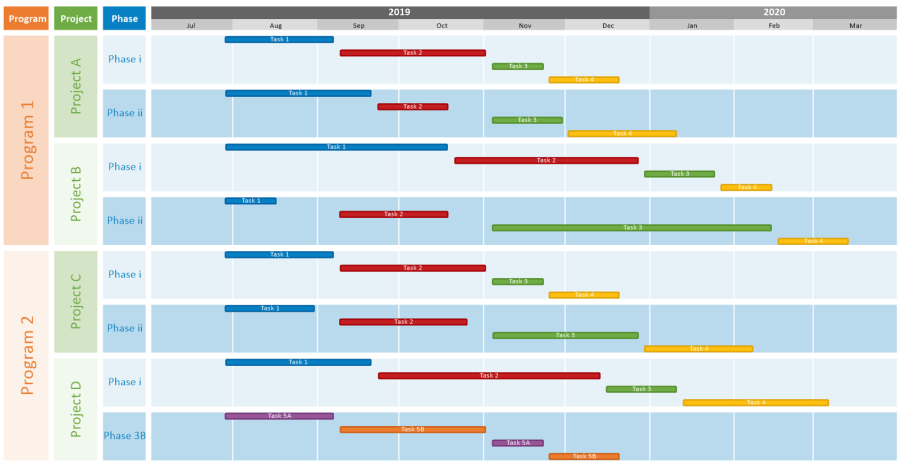
4) Supporting the new multiple swimlane level feature is a redesigned Template Properties and Chart Properties form's Rows/Swimlanes tab as shown below:
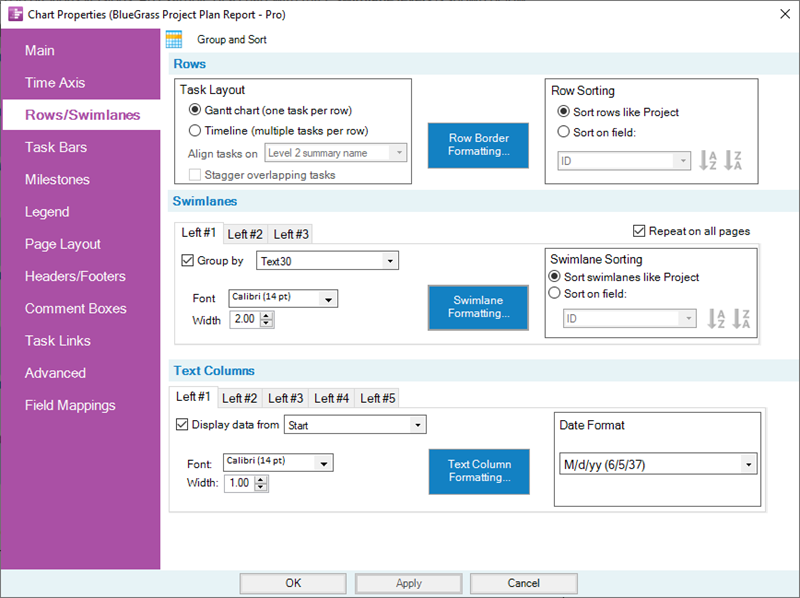
Schedule Presentation Considerations
5) If you are anticipating using one or more swimlane levels in a OnePager version 7.0 chart, it is important to give consideration to your schedule presentation's goals and objectives and select the chart organization is terms of swimlane levels that best meet these goals and objectives.
6) It may be that no swimlane levels need to be in the chart at all or that just one or two meets your needs.
7) Once the desired chart organization is determined, the steps below are provided as guidelines to creating the most beneficial chart.
Creating Charts Using Rows and Swimlanes
1) As the Rows/Swimlanes tab above illustrates, there is a step wise approach to constructing an informative and useful OnePager Pro or Express chart.
2) The general methodology is for you to create or modify the chart by making the following determinations based upon the goals and objectives you intend to meet with your schedule conversation:
Step 1) Determine carefully how the chart is going to look so that it best meets your goals and objectives.
- a) This means making the determination in terms of the need for swimlane levels, text columns, the collection of task bars into chart rows, and the grouping of rows in the chart into swimlane levels.
- b) It is important in this first step to determine how many swimlane levels are needed to organize the source plan data and which source plan fields are to be associated with each swimlane level you intend to show in the chart..
Step 2) Determine how source plan tasks are going to be collected into chart rows. This determination includes
- a) Determining how task bars are going to be sorted into the chart's rows.
- b) Determining how the chart's rows are going to be ordered or sorted within swimlane levels.
Step 3) Determine how chart's rows are going to be grouped into swimlane levels.
- a) This means setting the controls for which source plan fields is going to be associated with each swimlane level you intend to show in the chart.
- b) This also means determining how chart's rows are going to be grouped into swimlane levels keeping in mind that steps (a) and (b) are related.
Step 4) Determine how many additional text columns are going to be needed to adequately provide necessary information from the source plan for the audience without making the chart too busy..
Step 5) Determine how row and swimlane borders are going to be formatted.
3) Please keep in mind that OnePager assists you in these steps since you can always go back to the Chart Properties form after the first iteration of the chart is created and refine your setting and reassess how the chart communicates with respect to your goals and objectives.
5) The discussion that follows is divided into seven (7) sub-sections, one each for the steps listed above.
Step 1 - Determine the Configuration and Organization of the Chart
1) In majority of schedule presentation situations when you anticipate using multiple swimlane levels the organization of the swimlane levels and their associated source plan fields you are going to use are straight forward.
2) When this is not the case, it is recommended that consideration be given to reviewing the goals and objectives of the schedule conversation where the chart is used and characteristics of members of the audience.
3) Adding swimlane levels and text columns can make the chart look busy and distract from the intended theme.
4) Too few swimlane levels and text columns may hinder the message you are trying to communicate.
5) The same logic applies to the determination of how many text columns to include in the chart.
6) Since there are three (3) swimlane levels, they appear in the chart from left to right as Left#1, Left#2, and Left#3 as shown in the Chart Properties form's Rows/Swimlanes tab above.
- a) The highest swimlane level in a chart is the left-most swimlane level and successively lower swimlane levels appear going to the right.
- b) This means that you are encouraged to place the highest organizational level of the chart in the left-most swimlane level and so on.
- c)Doing so avoids repeating swimlane level cells within a lower swimlane level cell which probably makes the chart confusing and distracts from it communication value.
- d) It is also recommended to use as few swimlane levels as possible consistent with your schedule conversation message and the make up of the audience. You want to avoid taking time to explain the swimlane level configuration when your goals and objectives are within the graph area and the swimlanes and text columns are presented in support.
- e) After settling on these decisions, OnePager keeps track and provides consistent charts whenever you update your source plan and create an additional or modified snapshot.
Step 2 – Collect Source Plan Tasks into OnePager Chart Rows
1) Collecting tasks from your source plan into rows in the chart is usually done by selecting the Gantt chart layout where each chart row contains one task bar. You have the option to use the Timeline layout where multiple task bars occupy one row in the chart.
2) The controls for making these settings are found in the Template Properties form or Chart Properties form at the Rows/Swimlanes tab's Rows control group shown below:
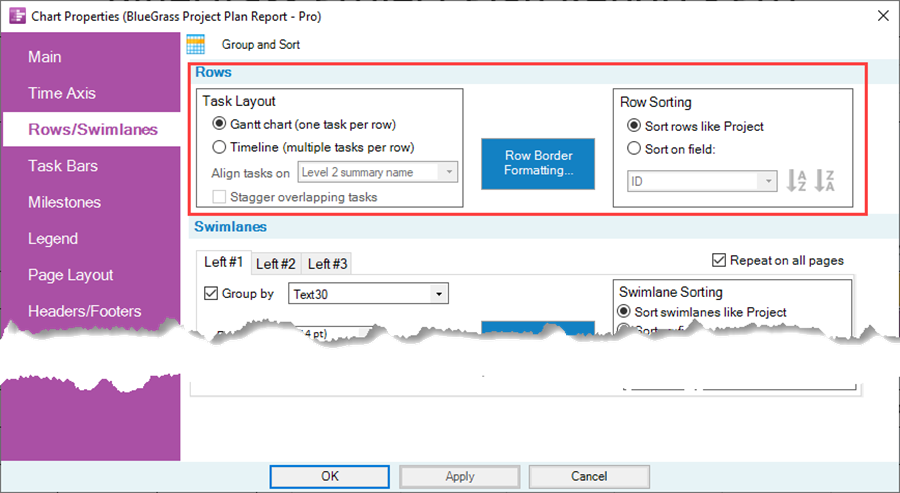
3) Once the selection between Gantt chart and Timeline layout is made, you have additional controls over how rows are sorted and borders formatted.
4) For more information on Task layout, please see the article at: TBD.
5) For more information on collecting and sorting source plan tasks into OnePager chart rows, please see the article at: TBD.
6) For more information on formatting row borders, please see the article at: TBD.
7)) After task bar collection into chart rows is determined, you can determine how chart rows should be grouped into swimlane levels.
Step 3 – Group Chart Rows into Swimlane Levels
1) When the decision is made to incorporate swimlane levels in the chart as well as the number of swimlane levels you can use the Swimlanes control group in the Chart Properties form's Rows/Swimlanes tab to implement these decisions.
2) The Chart Properties form at the Rows/Swimlanes tab is shown below:
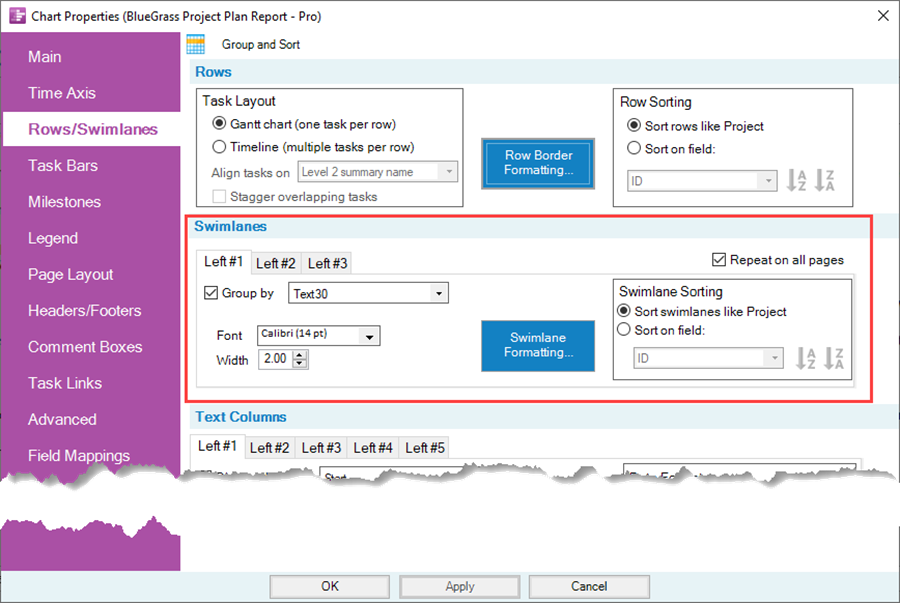
3) Each sub-tab shown above as Left#1, Left#2, and Left#3 are identical.
4) Checking the Group by checkbox ON in the sub-tab enables the swimlane level and the other controls in the sub-tab.
5) To implement your swimlane level decision with respect to the source plan field that the chart's rows are grouped into, it is necessary to use the window dropdown next to the Group by checkbox to make that selection.
6) Once made, you can use the Swimlane Formatting... button to access the Swimlane Formatting - Left#n form to make further settings pertaining to swimlane level heading cell labeling, swimlane level cell labeling, and swimlane level border settings as shown below:
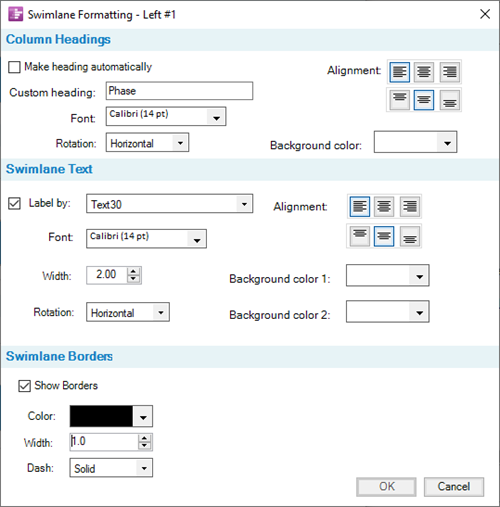
7) Note in the illustration above that the form's title includes the swimlane level number.
8) For more information on grouping chart rows into swimlane levels, please see the article at: TBD.
9) For more information on formatting swimlane components, please see the article at: TBD.
10) For more information on sorting swimlanes, please see the article at: TBD.
Step 4 – Order Swimlanes and/or Order Rows in Swimlanes
Order Rows in Swimlanes
1) You have two (2) options when controlling how rows will be ordered within swimlanes.
Order rows like Microsoft Project
2) Selecting this ordering technique uses the sequence from top to bottom provided by the Microsoft Project or Microsoft Excel source plan.
3) If several task shapes are collected into the same row, OnePager first sorts them into their natural Microsoft Project or Microsoft Excel order and then chooses the first task shape in the list to represent the entire row if ascending order is your choice.
4) If you choose descending order, OnePager uses the last task in the list.
Order rows by user selected Microsoft Project source plan field
5) You may choose to order rows under the control of data in a designated Microsoft Project or Microsoft Excel source plan field and further choose either ascending or descending order.
6) It should be pointed out that your Microsoft Project or Microsoft Excel source plan field used to order rows may be the same as your Microsoft Project or Microsoft Excel source plan field used to collect task shapes into rows or a different Microsoft Project or Microsoft Excel source plan field.
7) As discussed just above, OnePager chooses the first (last) value from list of values within each row when rows consist of task shapes with differing data.
Order Swimlanes
8) At this point, task shapes are assigned to rows and rows to swimlanes.
9) OnePager now uses the data from your Microsoft Project or Microsoft Excel source plan field to order the swimlane within the chart.
10) You have two (2) options when controlling how swimlanes are ordered.
Order swimlanes like Microsoft Project
11) Selecting this ordering technique establishes the sequence from top to bottom provided by your Microsoft Project or Microsoft Excel source plan.
12) Since the various task shapes comprising a swimlane have different natural occurrence orders, OnePager first performs the analysis at the task level within each swimlane to determine the swimlane ordering value to assign to the swimlane.
13) In other words, OnePager first sorts the set of task shapes comprising all the rows in the swimlane into their natural order and then chooses the first task shape in the list to represent the entire swimlane.
14) If you specified descending order, OnePager chooses the last task shape in the list to represent the entire swimlane.
Order swimlanes by Microsoft Project source plan field
15) You may choose to order swimlanes under the control of data in a specified Microsoft Project or Microsoft Excel source plan field.
16) As discussed in the item above, OnePager chooses the first (last) value from the list of values with each swimlane when swimlanes consist of rows that consist of task shapes with differing data in the designated Sort swimlanes by field.
17) At the completion of the ordering rows and swimlanes steps, you may choose to show text columns and swimlane labels as described below.
Step 5 – Label Rows and Swimlanes
Labeling Rows - General Considerations
1) If you check the Show text columns checkbox On, you must designate a Microsoft Project or Microsoft Excel source plan field to be used for OnePager to select the appropriate additional text columns.
2) Since task shapes may be collected into rows using your designated Microsoft Project or Microsoft Excel source plan field, there is a need to resolve conflicts when rows consist of task shapes with differing data in the designated Collect tasks into rows by field.
3) If there is more than one task shape in a row and these task shapes have different values from your designated Microsoft Project or Microsoft Excel source plan field, OnePager displays the label that occurs most frequently or the label that comes from the first task shape in the natural order of your Microsoft Project or Microsoft Excel source plan for task shapes with the same frequency of occurrence of label data.
Labeling Multiple Rows with the Custom Text Columns Form
4) OnePager Pro and Express allows the definition of up to five additional text columns.
5) These are defined by clicking the Text Column Properties... button shown above when the Show text columns checkbox is checked On.
6) When you do this, the Custom Text Columns form appears as shown below:
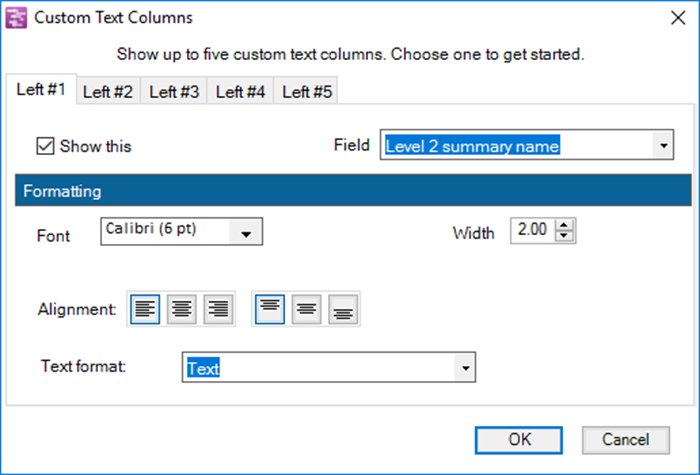
7) This form allows you to define up to five additional text columns which are displayed to the right of the chart's outer left border if Swimlanes are not displayed or to the immediate right of the Swimlanes label showing.
8) The additional text columns are defined from left to right.
9) For more information on the Custom Text Columns form, please see the article at: Creating and Editing Rows and Swimlanes (Portal). 12.0.1-70
10) The chart example below shows a chart with a swimlane and three text columns displayed as an example:
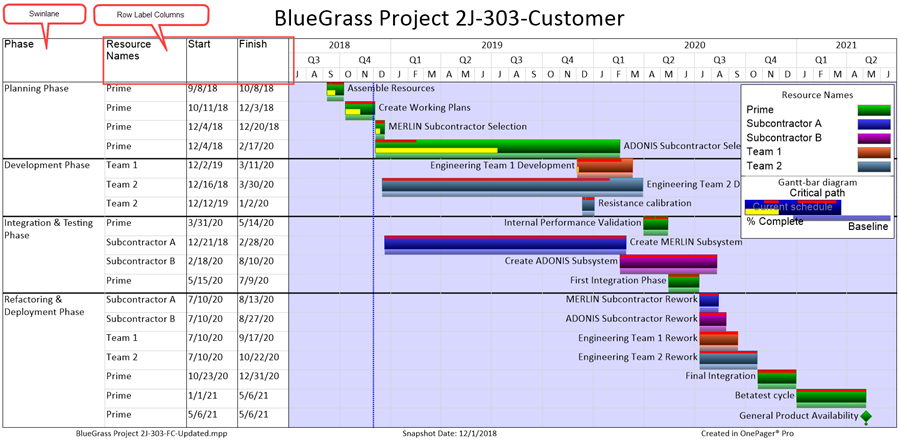
Labeling Swimlanes
11) If you check the Show swimlane labels checkbox On, you must designate a Microsoft Project or Microsoft Excel source plan field to be used for OnePager to select the appropriate swimlane label.
12) Since task shapes may be collected into rows using your Microsoft Project or Microsoft Excel source plan field and the rows grouped into swimlanes using another source plan field, there is a need to resolve conflicts when swimlanes consist of task shapes with differing data in the designated Label swimlanes by Microsoft Project or Microsoft Excel source plan field.
13) If there is more than one task shape in a swimlane and these task shapes have different values from your designated source plan field,
14) OnePager displays the swimlane label that occurs most frequently or the label that comes from the first task shape in the natural order of your Microsoft Project or Microsoft Excel source plan for task shapes with the same frequency of occurrence of label data.
15) Finally, you may cause row and swimlane labels to be repeated on all output pages if the multi-page feature is being used.
16) After completing the selection of optional labels for rows and swimlanes, you have the further option to control format of gridlines that OnePager places between rows and swimlanes as detailed in the discussion of Step 5 below.
Step 6 – Format Borders and Gridlines
1) As the final step in preparing your rows and swimlanes presentation, you may choose to turn on the row and swimlane borders feature.
2) This feature allows you to exercise control of borders around rows, around swimlanes, the inner frame of the chart, and the outer frame of the chart as detailed in the next sub-section.
Format Borders
3) When the Format Borders button is clicked, a form consisting of five (5) tabs is presented that allows you to control gridline color, width, and dash type.
4) The tabs are shown below and apply to:
- a) Swimlane borders
- b) Row borders
- c) Time cursor borders
- d) Inter frame borders
- e) Outer frame borders
4) Border commands for color, width, and dash type are as consistent as possible with those found in Microsoft Excel.
Swimlane borders, Row borders, Time cursors, Inner Frame and Outer Frame Common Controls
5) By clicking the Format borders… button in the Chart Properties form's Rows and Swimlanes tab you can configure borders for rows, swimlanes, and the other elements as shown below.
- a) Line color This dropdown list provides a color palette from which the line color for the border can be selected.
- b) Line width The line width for all borders is in units of font points.
- c) Dash type There are five (5) line or dash types available for borders which include: (1) Solid, (2) Dot, (3) Dash, (4) Dash dot, (5) Dash dot dot.
- d) Border type: There are three (3) border types available which include: (1) Above, (2) Below, (3) Both.
6) The four controls mentioned above are consistently used for three (3) of the five borders tabs.
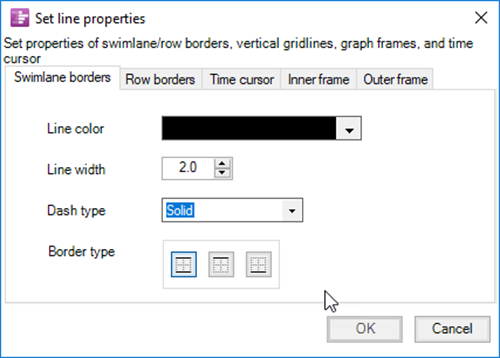
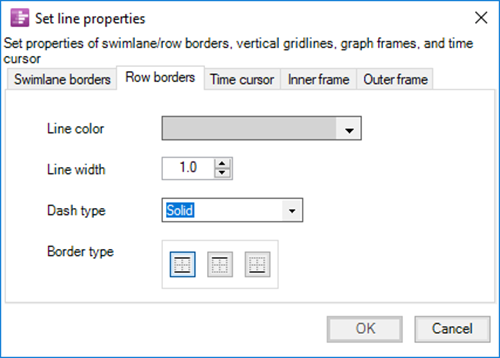
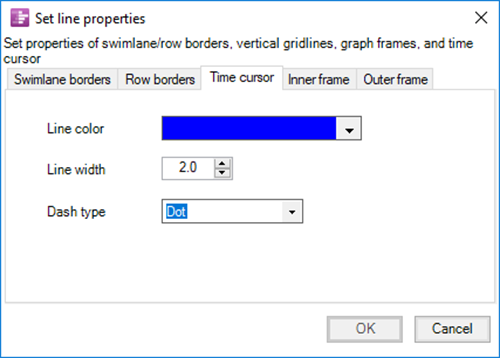
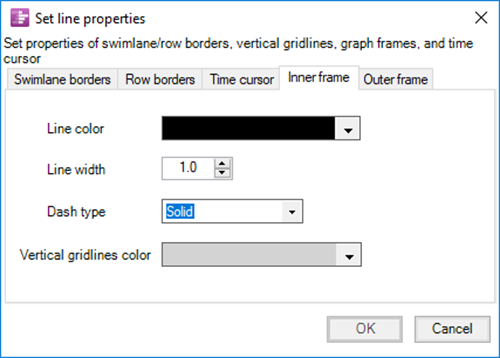
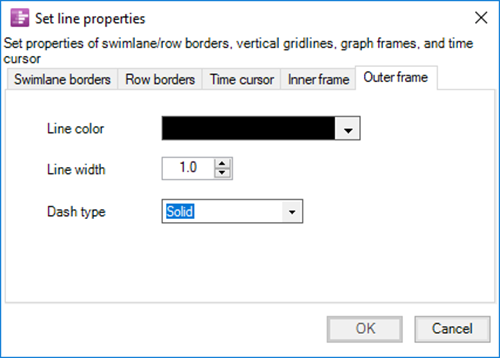
Vertical Gridlines Color
7) The Inner frame tab has an additional control for the color of the vertical gridlines.
8) Vertical gridlines are shown to place time separations on the graph.
9) Typically vertical gridlines are used to place separation between years or other major time boundaries.
10) The Inner frame tab below shows this control.
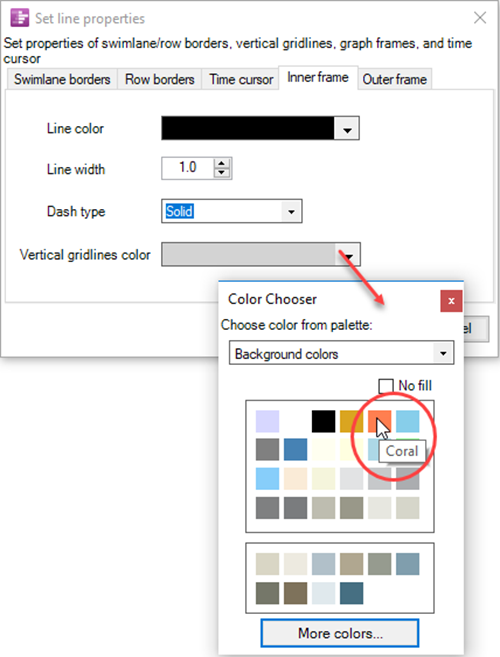
Example of Vertical Gridlines
11) The following segment of a chart illustrates the use of vertical gridlines:
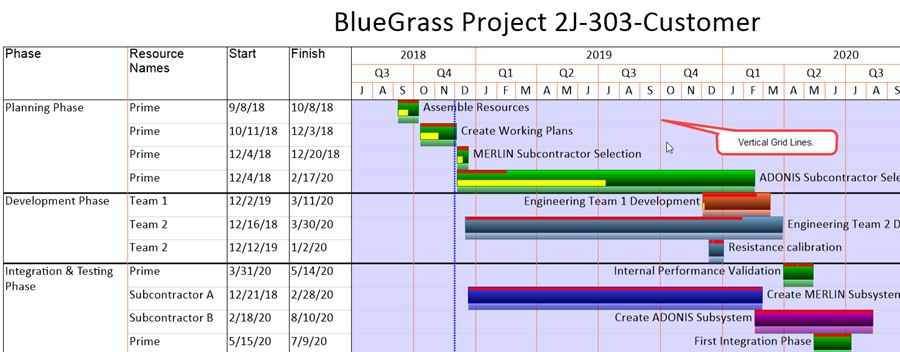
(4.0.1.5-70)